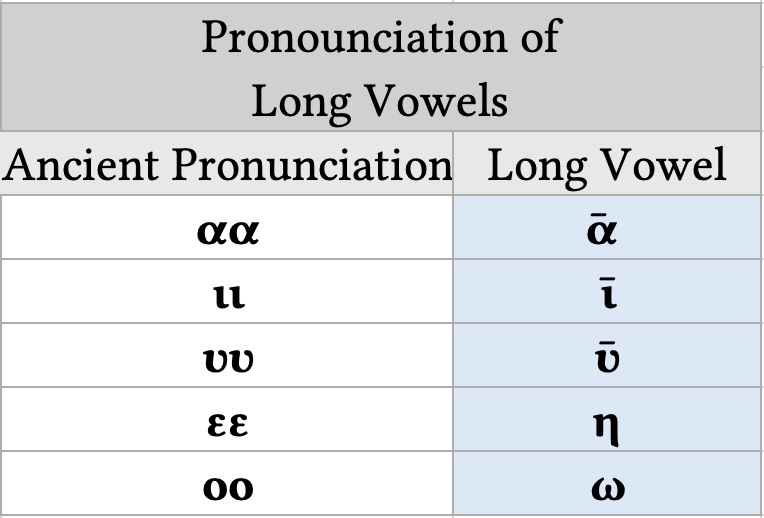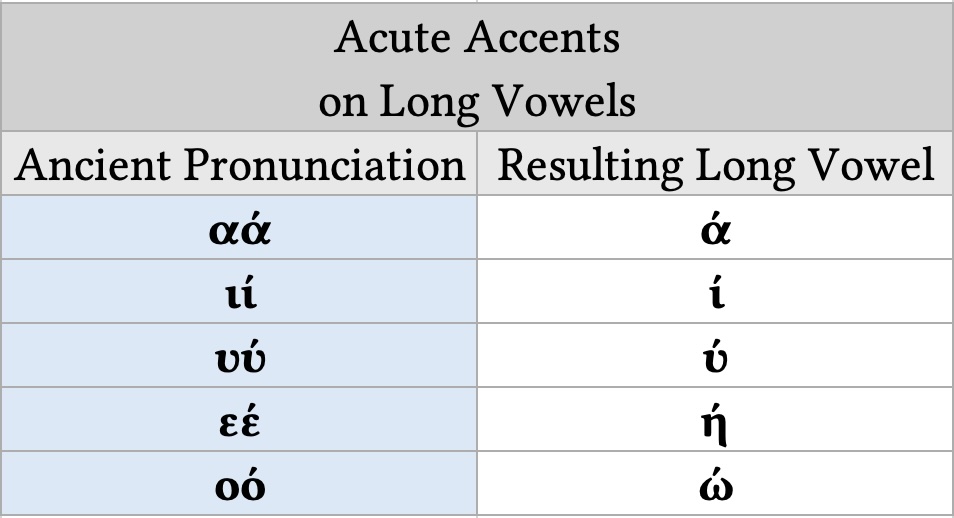There are three kinds of accent marks: ACUTE, GRAVE, and CIRCUMFLEX. Accents can fall on any of the last three syllables of a word. This applies even if a particular word is longer than three syllables. To facilitate discussion of syllables and accents, these last three syllables are commonly identified by the following terms:
ULTIMA: last syllable
PENULT: next-to-last syllable
ANTEPENULT: before the next-to-last syllable
- Read more
-
The terms ultima, penult, and antepenult derive from Latin: ultima (last), paene ultima (almost/next to last), and ante paene ultima (before the almost/next to last) syllaba (syllable).
3.4 Acute accents and short vowels
According to ancient grammarians, accent marks were originally used to indicate the musical tone or PITCH of a vowel sound, not the stress of a syllable (S 151, 161; G 9a). If there was a rising pitch on a single vowel sound, they marked the vowel with a line rising from left-to-right: /. This is called the ACUTE ACCENT.
The vowels ᾰ, ε, ῐ, ο, and ῠ are short. If accented, they receive the acute accent: ά, έ, ί, ό, and ύ. As with breathing marks, acute accents are placed directly above lower-case vowels, immediately to the left of capital letters, or over the second vowel of a diphthong. If an accented vowel also has a breathing mark, the breathing mark precedes the acute accent.
For example: ἄνθρωπος, Ὅμηρος, αἴξ
3.5 Acute accents and long vowels
The vowels ᾱ, η, ῑ, ω, and ῡ are long. In the Greek language, long vowels were TWO-BEAT vowel sounds. In other words, these vowels would take twice as long to pronounce as short vowels.
Though modern speakers tend not to hold these Greek long vowels for two beats, understanding the original Greek concept of the two-beat vowel sound is critical if we are to understand the Greek accent system. This is because, when pronouncing long vowels, only one of the two beats could receive the pitch accent. If it is the second beat, then only the rising tone, or acute accent (/), is written. For example:
If the first beat of a long vowel bears the pitch accent, then the long vowel begins with a rising tone (/), followed by a falling tone that marks the absence of a pitch sound (\). These vowels are marked with a CIRCUMFLEX ACCENT (^). For example:
As a result, a circumflex accent can never occur on a short vowel (S 156, G 11a).
The placement rules for the circumflex accent follow that of acute accents, with one exception: if an accented vowel also has a breathing mark, the breathing mark is placed under the circumflex accent.
For example: ἧλιος, εὖ, αἷμα
In cases where the rise in pitch – marked by an acute accent – occurs on the ultima, the pitch rise was regularly left unpronounced if another word followed in the sentence. In such cases, the acute accent symbol is inverted, and the final syllable is marked by a GRAVE ACCENT: \.
As a result, grave accents can only be found on a word's ultima.
For example: τιμή → τιμὴ δέ.
- Read more
-
GRAVE ACCENTS essentially mark the absence of a pitch tone in a vowel sound. In some early manuscripts, all vowel sounds not marked by an acute or circumflex were marked by grave accents (e.g. τιμή would be written τὶμή). Eventually, the grave came to be used only when it replaced an acute on a word’s final syllable (S 155; cf. G 9-15).




